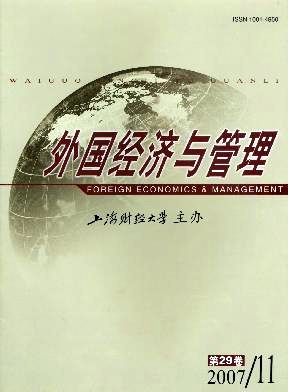组织与环境共同演化理论研究述评
外国经济与管理 2007 年 第 29 卷第 11 期, 页码:9 - 17
摘要
参考文献
摘要
共同演化理论正在成为当前研究的热点议题。本文从共同演化的生物学源起、在社会文化领域的扩张及组织战略领域的发展等方面来探寻共同演化思想的发展轨迹,从共同演化的内涵与特征、分析思路与框架、对战略选择与环境天择论争的回应等角度来梳理共同演化理论的基本思想,最后对该领域的研究现状和发展趋势进行了评介与展望,以期为后续研究奠定基础。
[1]Norgaard,R.Development betrayed:The end of progress and a co-evolutionary revisioning of the future[M].London:Routledge,1994.
[2]Kallis,G.Socio-environmental co-evolution:Some ideas for an analytical approach[J].The International Journal of Sustainable De-velopment and World Ecology,2007,14:4-13.
[3]Ehrlich,P,and Raven,P.Butterflies and plants:Astudy in coevolution[J].Evolution,1964,18(4):586-608.
[4]Murmann,J P.Knowledge and competitive advantage:The coevolution of firms,technology,and national institutions[M].NewYork:Cambridge University Press,2003.
[5]刘志高,尹贻梅.演化经济学的理论知识体系分析[J].外国经济与管理,2007,29(6):1-6.
[6]Volberda,H W,and Lewin,A Y.Co-evolutionary dynamics within and betweenfirms:Fromevolutionto co-evolution[J].Journal ofManagement Studies,2003,40(8):2 111-2 136.
[7]Norgaard,R.Coevolutionary agricultural development[J].Economic Development and Cultural Change,1984,32(3):525-547.
[8]Winder,N,McIntosh,B S,and Jeffrey,P.The origin,diagnostic attributes and practical application of co-evolutionary theory[J].Ecological Economics,2005,54(4):347-361.
[9]McKelvey,B.Quasi-natural organization science[J].Organization Science,1997,8(4):352-380.
[10]Madhok,A,and Liu,C.Acoevolutionary theory of the multinational firm[J].Journal of International Management,2006,12(1):1-21.
[11]Suhomlinova,O.Toward a model of organizational co-evolutionin transition economies[J].Journal of Management Studies,2006,43(7):1 537-1 558.
[12]Tan,J,and Tan,D.Environment-strategy co-evolution and co-alignment:Astaged model of Chinese soes under transition[J].Stra-tegic Management Journal,2005,26(2):141-157.
[13]Porter,T B.Coevolution as a researchframeworkfor organizations and the natural environment[J].Organization&Environment,2006,19(4):479-504.
[14]Lewin,A Y,and Volberda,H W.Prolegomena on coevolution:Aframeworkfor research on strategy and neworganizational forms[J].Organization Science,1999,10(5):519-528.
[15]Lewin,A Y,Long,C P,and Carroll,T N.The coevolution of new organizational forms[J].Organization Science,1999,10(5):535-542.
[16]Baum,J,and Singh,J.Evolutionary dynamics of organizations[M].New York:Oxford University Press,1994.
[17]Aldrich,H E.Organisations evolving[M].London:Sage Publications,1999.
[18]McKelvey,B.Managing coevolutionary dynamics[R].the 18th Egos Colloquium,2002.
[19]Henderson,A D,and Stern,I.Selection-basedlearning:The coevolution of internal and external selectionin high-velocity environ-ments[J].Administrative Science Quarterly,2004,49(1):39-75.
[20]Kallis,G.Whenis it coevolution?[J].Ecological Economics,2007,62(1):1-6.
[2]Kallis,G.Socio-environmental co-evolution:Some ideas for an analytical approach[J].The International Journal of Sustainable De-velopment and World Ecology,2007,14:4-13.
[3]Ehrlich,P,and Raven,P.Butterflies and plants:Astudy in coevolution[J].Evolution,1964,18(4):586-608.
[4]Murmann,J P.Knowledge and competitive advantage:The coevolution of firms,technology,and national institutions[M].NewYork:Cambridge University Press,2003.
[5]刘志高,尹贻梅.演化经济学的理论知识体系分析[J].外国经济与管理,2007,29(6):1-6.
[6]Volberda,H W,and Lewin,A Y.Co-evolutionary dynamics within and betweenfirms:Fromevolutionto co-evolution[J].Journal ofManagement Studies,2003,40(8):2 111-2 136.
[7]Norgaard,R.Coevolutionary agricultural development[J].Economic Development and Cultural Change,1984,32(3):525-547.
[8]Winder,N,McIntosh,B S,and Jeffrey,P.The origin,diagnostic attributes and practical application of co-evolutionary theory[J].Ecological Economics,2005,54(4):347-361.
[9]McKelvey,B.Quasi-natural organization science[J].Organization Science,1997,8(4):352-380.
[10]Madhok,A,and Liu,C.Acoevolutionary theory of the multinational firm[J].Journal of International Management,2006,12(1):1-21.
[11]Suhomlinova,O.Toward a model of organizational co-evolutionin transition economies[J].Journal of Management Studies,2006,43(7):1 537-1 558.
[12]Tan,J,and Tan,D.Environment-strategy co-evolution and co-alignment:Astaged model of Chinese soes under transition[J].Stra-tegic Management Journal,2005,26(2):141-157.
[13]Porter,T B.Coevolution as a researchframeworkfor organizations and the natural environment[J].Organization&Environment,2006,19(4):479-504.
[14]Lewin,A Y,and Volberda,H W.Prolegomena on coevolution:Aframeworkfor research on strategy and neworganizational forms[J].Organization Science,1999,10(5):519-528.
[15]Lewin,A Y,Long,C P,and Carroll,T N.The coevolution of new organizational forms[J].Organization Science,1999,10(5):535-542.
[16]Baum,J,and Singh,J.Evolutionary dynamics of organizations[M].New York:Oxford University Press,1994.
[17]Aldrich,H E.Organisations evolving[M].London:Sage Publications,1999.
[18]McKelvey,B.Managing coevolutionary dynamics[R].the 18th Egos Colloquium,2002.
[19]Henderson,A D,and Stern,I.Selection-basedlearning:The coevolution of internal and external selectionin high-velocity environ-ments[J].Administrative Science Quarterly,2004,49(1):39-75.
[20]Kallis,G.Whenis it coevolution?[J].Ecological Economics,2007,62(1):1-6.
引用本文
李大元, 项保华. 组织与环境共同演化理论研究述评[J]. 外国经济与管理, 2007, 29(11): 9–17.
导出参考文献,格式为:





 5898
5898  336
336

